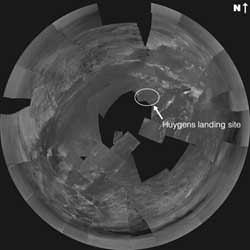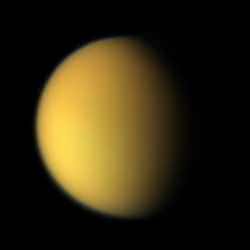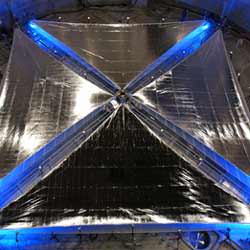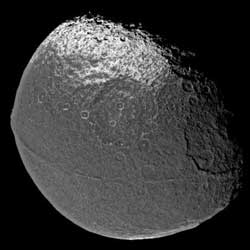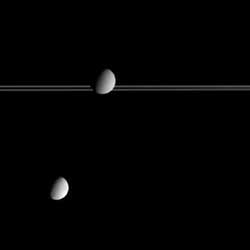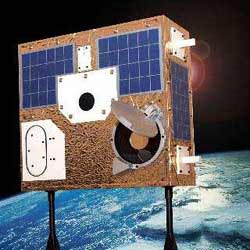
The suitcase-sized MOST space telescope. Image credit: MOST. Click to enlarge.
MOST, Canada’s first space telescope, has turned up an important clue about the atmosphere and cloud cover of a mysterious planet around another star, by playing a cosmic game of `hide and seek’ as that planet moves behind its parent star in its orbit.
The exoplanet, with a name only an astrophysicist could love, HD209458b (orbiting the star HD209458a), cannot be seen directly in images, so the scientists on the MOST (Microvariability & Oscillations of STars) Satellite Team have been using their space telescope to look for the dip in light when the planet disappears behind the star. “We can now say that this puzzling planet is less reflective than the gas giant Jupiter in our own Solar System,” MOST Mission Scientist Dr. Jaymie Matthews announced today at the annual meeting of the Canadian Astronomical Society in Montréal. “This is telling us about the nature of this exoplanet’s atmosphere, and even whether it has clouds.”
Many of the planets discovered around other stars, known as exoplanets or extrasolar planets, hug surprisingly close to their parent stars; HD209458b orbits at only 1/20th of the Earth-Sun distance (an Astronomical Unit or AU). It could never support life as we know it. But understanding HD209458b is a key piece in the puzzle of planet formation and evolution that is revising theories of our own Solar System, and estimates of how common are habitable worlds in our Galaxy. How a giant ball of gas that is larger than the planet Jupiter (which orbits 5 AU from our Sun) got so close to its star, and how its atmosphere responds to the powerful radiation and gravitation fields of that star, are still open questions to exoplanetary scientists.
“The way this planet reflects light back to us from the star is sensitive to its atmospheric composition and temperature,” describes Jason Rowe, a Ph.D. student at the University of British Columbia who processed the MOST data. “HD209458b is reflecting back to us less than 1/10,000th of the total visible light coming directly from the star. That means it reflects less than 30-40% of the light it receives from its star, which already eliminates many possible models for the exoplanetary atmosphere.” By comparison, the planet Jupiter would reflect about 50% of the light in the wavelength range seen by MOST.
“Imagine trying to see a mosquito buzzing around a 400-Watt streetlamp. But not at the street corner, or a few blocks away, but 1000 km away!” explains Dr. Matthews. “That’s equivalent to what we’re trying to do with MOST to detect the planet in the HD209458 system.”
The planet was detected directly earlier this year in the infrared by NASA’s US$720M Spitzer Space Observatory. At a wavelength of 24 micrometres, about 50,000 times longer than the light waves seen by human eyes, the exoplanet HD209458b is actually faintly glowing, with what physicists call “thermal emission.” MOST looks at the Universe in the same wavelength range as the eye. By combining the Spitzer far-infrared thermal result with the MOST visible light reflection limit, theoreticians are now able to develop a realistic model of the atmosphere of this so-called “hot Jupiter.”
And MOST has not given up on HD209458b. “It can orbit, but it can’t hide,” quips Dr. Matthews. “MOST will put this system under a 45-day stakeout at the end of the summer to continue to improve our detection limit. Eventually, the planet will emerge from the noise and we’ll have a clearer picture of the composition of the exoplanet atmosphere and even its weather – temperature, pressure and cloud cover.”
A scientific paper on these results will be submitted soon, by Jason Rowe and Dr. Jaymie Matthews (UBC), Dr. Sara Seager (Carnegie Institute of Washington), Dr. Dimitar Sasselov (Harvard-Smithsonian Center for Astrophysics), and the rest of the MOST Science Team, with members from UBC, the University of Toronto, Université de Montréal, St. Mary’s University, and the University of Vienna.
Dr. Seager, a world leader in the field of modelling exoplanet atmospheres, emphasises the challenge of this kind of science: “We’re like weather forecasters trying to understand winds and clouds on a world we can’t even see. It’s hard enough for meteorologists to tell you whether it will be cloudy tomorrow in your hometown here on Earth. Imagine what it’s like to try to forecast weather on a planet 150 light years away!”
Dr. Sasselov is also excited by MOST’s early findings: “This capability of MOST is paving the way to the great prize – the discovery of Earth-sized planets. The search for other worlds like home is now on.” Dr. Matthews can’t resist adding, “Not bad for a space telescope with a mirror the size of a pie plate and a price tag of Can$10M, eh?”
MOST (Microvariability & Oscillations of STars) is a Canadian Space Agency mission. Dynacon Inc. of Mississauga, Ontario, is the prime contractor for the satellite and its operation, with the University of Toronto Institute for Aerospace Studies (UTIAS) as a major subcontractor. The University of British Columbia (UBC) is the main contractor for the instrument and scientific operations of the MOST mission. MOST is tracked and operated through a global network of ground stations located at UTIAS, UBC and the University of Vienna.
Original Source: CASCA News Release


